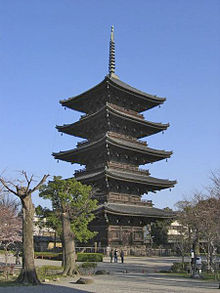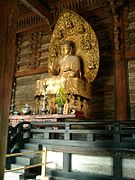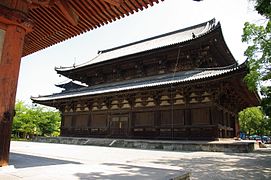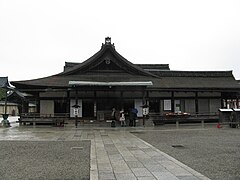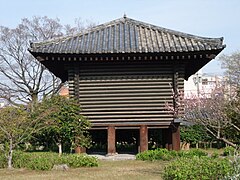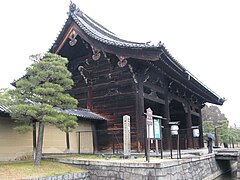Tō-ji
The Tō-ji ( Japanese 東 寺 , literally: "Eastern Temple"), also Kyōō Gokoku-ji ( 教 王 護国寺 , for example: "The temple protecting the land of the king of teaching") is a Buddhist temple in the Minami district of the city of Kyoto in Japan . It is the main temple of the Tō-ji branch of the Shingon-shū and thus namesake for the branch of esoteric Buddhism cultivated on it , the Tōmitsu ( 東 密 ).
Building history
Since the priests with their temples had become too powerful in the capital of the country, Heijō-kyō (today Nara), the imperial court decided to build a new city in which only space was provided for two temples. This new city, the construction of which began in the year 794, was called Heian-kyō , the planned temples "East Temple" and "West Temple" called. For them a place was provided east and west of the north-south axis, which was completed by the Rajōmon (羅 城門). The Sai-ji was already lost in the 13th century, the To-ji was given to the monk Kūkai by the emperor Saga, who abdicated shortly afterwards, in 823, the construction work was still not completed .
The temple complex
As no buildings from the founding time have been preserved, the original facility is unknown. Today's temple complex, however, follows the old "seven-building complex" (七 堂 伽藍, Shichidō garan) handed down from Nara, consisting of a main hall, teaching hall, refectory, pagoda, bell tower, sutras and monks 'quarters, although the bell tower and monks' quarters are missing here .
The main entrance to the temple leads through the large south gate (南 大門, Nandaimon; [S] in the temple plan), which was moved here from the Sanjūsangen-dō temple . It comes from the Momoyama period and is registered as an important cultural asset (◎). It has a gable roof that is covered with tiles. - Further gates are the big east gate (大 東門, Daihigashimon, closed), further north on the east side the Keiga gate (慶賀 門, [T]), in the north the big north gate (大 東門, Daikitamon [N]) and open on the west side the lotus gate (蓮花 門, Rengemon [E]), which dates back to the Kamakura period and is therefore the oldest of the temple gate. It is registered as a national treasure (⦿).
On the right hand is the five-story pagoda (五 重 塔, Gojū-no-tō; ⦿; [P]), which was rebuilt in 1644. It is the highest existing pagoda in Japan with a height of 56 m. Inside there are colored pictures of the eight founding fathers of Shingon, painted on wood. The pagoda is now surrounded by a green area with trees and a long pond.
If you look to the north, you can see the main hall (金堂, Kondō; ⦿, [1]). It is an example of a temple building from the Momoyama period. The interior is designed based on the Zen style. The Yakushi Buddha is worshiped with two companions (薬 師 三尊, Yakushi Sanzon; ◎).
Behind the main hall follows the teaching hall (講堂, Kōdō; ◎; [2]) from the Muromachi period. The most important deities for Shingon are set up there. They are believed to date from the time the temple was founded, i.e. from the 9th century, and are the oldest preserved original display in Japan.
The installation in the teaching hall
| No. | Kanji | Name Jap. | No. | Kanji | Name Jap. | No. | Kanji | Name Jap. |
| Five Buddhas | 8th | 金剛 薩 埵 菩薩 | Kongosatta Bosatsu | Prince of Heaven, left | ||||
| 1 | 大 日 如 来 | Dainichi Nyorai | 9 | 金剛 法 菩薩 | Kongōhō Bosatsu | 16 | 広 目 天 | Kōmoku Ten |
| 2 | 不 空 成就 如 来 | Fukūjōju Nyorai | 10 | 金剛 宝 菩薩 | Kongōhō Bosatsu | 17th | 帝 釈 天 | Teisha Ten |
| 3 | 阿 閦 如 来 | Ashuka Nyorai | Five shining kings | 18th | 増 長 天 | Sōjō Ten | ||
| 4th | 阿 弥陀 如 来 | Amida Nyorai | 11 | 不 動 明王 | Fudō Myoō | Prince of Heaven, right | ||
| 5 | 宝 生 如 来 | Hōshō Nyorai | 12 | 大 威 徳 明王 | Daiitoku Myōō | 19th | 多 聞 天 | Tamon Ten |
| Five bosatsu | 13 | 金剛 夜叉 明王 | Kongōyasha Myōō | 20th | 梵天 | Bon Ten | ||
| 6th | 金剛 波羅蜜 菩薩 | Kongōhara Bosatsu | 14th | 軍 茶 利明 王 | Gundari Myōō | 21st | 持 国 天 | Jikoku Ten |
| 7th | 金剛 業 菩薩 | Kongōgyō Bosatsu | 15th | 降 三世 明王 | Gozanze Myōō | |||
Behind the teaching hall follows the refectory in the north (食堂, Shikidō; [3]). Inside are a thousand-armed Kannon (千手 観 音, Senju Kannon), a Jizō-bosatsu (地 蔵 菩薩) and Bunju bosatsu (文殊 地 蔵 菩薩) , all of which come from the Heian period and are registered as important cultural assets. During a restoration of the Kannon figure in 1961, a small plate was found inside that was dated 877. There is also a Tobatsu Bishamon (兜 初 毘 沙門; ⦿) from the Tang period , which comes from the upper floor of the former south gate of the city of Kyoto (then called Rashomon (羅 生 門)) when the place was still called Heian-kyō . He has a (戟) in his left hand and a small pagoda in his right hand and is accompanied by two little devils. This sculpture came here from xx in the year 742. In China there is no longer a figure of this type, in Japan numerous copies were made, adapted to Japanese tastes.
To the west of the refectory is the large teacher hall (大師 堂, Daishidō, also Saiin Miedō (西 院 御 影 堂); Fudōdō (不 動 堂); ⦿; [L]) from the Muromachi period. The hall is covered with cedar shingles, the doors and the rain protection of the windows show the style of the time. In the back room there is a Fudō-Myōō (不 動 明王; ⦿) from the Heian period.
To the left hand in the southwest corner of the temple is the Kanchō-in (灌頂 院; [A]) surrounded by a wall , in which the secret rites of the Shingon were held. The building dates from the Edo period , the east gate (東門, Higashi-mon; ◎) and the north gate (北 門, Kita-mon; ◎) to this area date from the Kamakura period .
Temple treasures
Among the temple treasures are the colored scrolls of the seven founding fathers of Shingon (真言 七 祖 像; Nara period; ⦿), the oldest colored mandala pair of the two worlds (両 界 曼荼羅 図; Heian period; ⦿), the hanging scrolls the five venerated Buddhas (五大 尊像; Heian period; ⦿), the twelve kings of heaven (十二 天 像; Kamakura period; ⦿) by Takuma Shoga (宅 間 勝 賀), which are mounted on a six-part screen. They stand for the twelve Tengu (天 供) of the Shingon.
The handicraft treasures include the devices used in the Shingon rites from the ( Tang period ; ⦿)
photos
history
antiquity
Construction began around 793 on the orders of the Kammu -tennō. It initially acted as a protective temple for Kyōto (then still Heian-kyō ). He stood on one side of the Rajōmon , one of the two large city gates of the then capital of the country, on the other side of the (now defunct) Sai-ji ("West Temple"). This pattern should correspond to that of the two great temples in the old capital Nara ( Tōdai-ji and Saidai-ji ).
In 823, the construction work was still not completed, it was transferred to the monk Kūkai by the Saga -tennō , who abdicated shortly afterwards , who, with the permission of Junna -tennō, housed 50 monks of the Shingon-shū he founded and thus made the temple exclusive Control of his school brought - the historically first exclusive use of a temple by a single school in Japan. The official recognition of the school by the government was completed by the written fixation of this process in the official documents, in which the word "Shingon-shu" appeared for the first time. At the same time, the temple received its official new name ( Kyō-ō Gokoku-ji ).
In 828, on Tō-ji, Kūkai opened the first generally accessible school in Japan, the Shugeishuchi-in ( 綜 芸 種 智 院 ) with a curriculum that mainly consisted of Buddhist, Confucian and Daoist studies. However, this school remained a short-term experiment and was closed again in 847.
In 831 Kūkai put down his office as the highest-ranking priest at the Tō-ji ( 東 寺 長者 , Tō-ji-chōja ) for health reasons and handed it over to Jitsue ( 実 恵 , also Jichie ; 786-847), while he wrote his writings there to his younger brother Shinga ( 真 雅 ; 801–79) entrusted. Jitsue sold the Shugeishuchi-in facilities to finance a Shingon class at the temple.
After Jitsue, Shinzei ( 真 済 ; 800-860) became head of the Tō-ji, who had previously exercised this position on the Takaosan-ji . Shinzei was able to gain three additional Nembundosha positions in addition to the three existing Shingon-shū in 853 (Nembundosha ( 年分 度 者 ) were priests who were appointed annually by the government and represented the respective schools or temples). From then on, these had to be patterned on the Tō-ji.
Shinzei's successor at Tō-ji was Shinga.
Jitsue's student Shūei ( 宗 叡 ; 809–84) was Shinga's successor.
Shūei's successor at Tō-ji was Shinga's disciple Shinnen ( 真 然 , also Shinzen ; 804-91), who changed to Kōya-san in 876 and took Kūkai's writings there with him. Priests at Tō-ji immediately requested these texts back, especially Kūkai's collection of secret writings called Sanjūjō sakushi ( 三十 帖 冊子 ), but Shinnen refused. Shinnen also persuaded the imperial court in 882 to have the Nembundosha of the Shingon-shū no longer patterned on the Tō-ji, but on the Kōya-san. This became another basis of the dispute between Kōya-san and Tō-ji.
Shinnen's successor at Tō-ji was Shūei's disciple Yakushin ( 益 信 ; 827-906), who ordained the abdicated Tennō Uda at the temple in 901 . Yakushin asked the imperial court in 897 to have all six Nembundosha of the Shingon-shū patterned at the Tō-ji again, but was successful. This issue was finally settled in 907 by Uda by granting the Tō-ji their own Nembundosha - this practice of giving the Shingon temples their own Nembundosha positions later became common and ultimately led to the institutional fragmentation of the Shingon-shū.
Yakushin's successor was Shinnen's pupil Shōbō ( 聖 宝 ; 832-909). His pupil Kangen ( 観 賢 ; 853-925) was his successor in 912 and was involved in the dispute over the Sanjūjō sakushi : In the same year he demanded the return of the priest Mukū ( 無 空 ;? -918), the 894 high priest at Kongōbu- ji and in whose hands the script was at the time. Mukū refused, and Kangen caused the abdicated Tennō Uda to order Mukū to be returned in writing. Even before the order came in the last month of 915, Muku left the Temple with the Scriptures and his disciples to settle in Iga Province . Thereupon Kangen was appointed simultaneous head of Daigo-ji , Kongōbu-ji and Tō-ji, uniting the previously fragmented Shingon-shū under the authority of Tō-ji. In 919 Kangen was finally able to bring Kūkai's writings back to Tō-ji. Significant for the actual nullity of the dispute is the fact that the Sanjūjō sakushi was borrowed in the early Kamakura period by a priest from Ninna-ji , where it is still located today.
middle Ages
In the early Kamakura period , the temple was largely forgotten and in a dilapidated condition. Only with the help of the abdicated Tennō Go-Uda , who was ordained there in 1308, could it be restored piece by piece. However, it never regained its former glory as a center of the Shingon-shū and has only played an insignificant role since the decline of the aristocracy that had previously supported it in the Muromachi period .
This period, however, produced a number of priests, among whom Shingon studies on Tō-ji flourished. These three priests, also known as the " Three Jewels of the Tō-ji" ( 東 寺 三宝 , tō-ji-san-pō ), were Raihō ( 頼 宝 ; 1279–1330), Gōhō ( 杲 宝 ; 1306–1362) and Genpō ( 賢 宝 ; 1333–1398).
Modern
1994 Tō-ji, together with other historic sites in Kyoto by the UNESCO for World Heritage Historic Kyoto (Kyoto, Uji and Otsu Cities) appointed.
On July 7, 2007, a special concert of the worldwide benefit event series Live Earth took place on the temple grounds . Performing musicians included Bonnie Pink , Michael Nyman , Rip Slyme , UA and Yellow Magic Orchestra .
The "Archive of the Toji Temple in one hundred boxes" ( Tōji Hyakugō Monjo ) has been a UNESCO World Heritage Site since 2015 . It consists of 24,147 individual records of the temple's religious and political activities, as well as the management of its goods, collected between the years 763-1711.
The Kanchi-in
The Kanchi-in (観 智 院; K in the above plan) is a Buddhist temple that belongs to the Tō-ji. The temple was built at the instigation of the Emperor Go-Uda by the monk Gohō (宝; 1306-1362). In the following period it was led by learned monks and led by the Tō-ji as a secondary temple. Tokugawa Ieyasu decreed that the temple proclaimed the Shigon direction of Buddhism. - The reception hall (客 殿, Kyakuden) was rebuilt in 1605; it is listed as a national treasure.
Individual evidence
- ^ "Archives of Tōji temple contained in one-hundred boxes" , UNESCO Memory of the World, accessed February 9, 2016.
literature
- Kyoto-fu rekishi isan kenkyukai (ed.): Tō-ji . In: Kyoto-fu no rekishi sampo (chu). Yamakawa Shuppan, 2011. ISBN 978-4-634-24726-0 .
Web links
- Information provided by Kyoto Prefecture (English)
- Information offered by the city of Kyoto (English)
Coordinates: 34 ° 58 ′ 51 ″ N , 135 ° 44 ′ 51 ″ E
